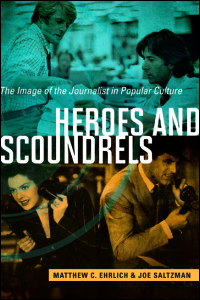
Heroes and Scoundrels:
The Image of the Journalist in Popular Culture

By Matthew C. Ehrlich
Professor of journalism at the
University of Illinois at Urbana-Champaign
and
Joe Saltzman
Professor of journalism and communication
at the University of Southern California
Publication date: April 2015. University of Illinois Press
War
Chapter Six
War reporting commands unique prestige, having been viewed as “the ultimate journalistic challenge” and “a glamorous specialism of journalism” that is practiced by “an elite, specialized class apart and above regular reporters.” Simultaneously, according to Stuart Allan and Barbie Zelizer, “it is beset by an array of problems associated with allegiance, responsibility, truth, and balance.” Those on the political left have criticized war reporting for amounting to nothing but propaganda. In the words of one scholar, it demonstrates “the incredible consistency of journalists, editors, and news outlets in internalizing and disseminating official views, and at the expense of dissenting public views.” Those on the political right have questioned the news media’s patriotism during wartime, in effect demanding to know of journalists, “are you with us, or are you against us?” At worst, journalists have been accused of actively undermining the war effort, or (as was the case with the American military and the Vietnam War) even contributing to outright defeat.
In this chapter we examine how popular culture reflects the conflicted image of war reporting. Although there have been notable exceptions, the war correspondent has been regularly portrayed as a hero whose job requires day-to-day courage and toughness. At the same time, those correspondents have confronted both pointed questions about their loyalties and blatant attempts to manipulate or intimidate them. Their efforts to remain as neutral observers fail again and again, and the terrible things they witness threaten to do them irrevocable harm.
Ehrlich-Saltzman, Heroes and Scoundrels: The Image of the Journalist in Popular Culture – pages 121-122. ©University of Illinois Press, 2015
Popular culture’s stories about war and journalism do their own part in that same task. They also offer the hope that amid all the world’s evils, war correspondents and the rest of us can finally find a measure of grace.
Ehrlich-Saltzman, Heroes and Scoundrels: The Image of the Journalist in Popular Culture – page 140. ©University of Illinois Press, 2015
This chapter includes: Pre-World War II Correspondents, Correspondents in World War II, Vietnam-Era Correspondents, War Correspondents in the Post-Vietnam Age.
Other Resources:
The Depiction of War Reporters in Hollywood Feature Films from the Vietnam War to the President by Stephen Badey, Film History (Australia) 2002 14 (3-4): 243-260
Film Portrayals of Foreign Correspondents by Raluca Cozma and John Maxwell Hamilton, Manship School of Mass Communication, Louisiana State University, Baton Louge, August 2009, Journalism Studies ,10:4,489 - 505
Check out the other chapters: